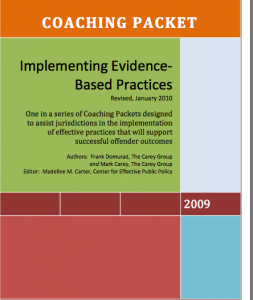 THE BEST OF: The following article, initially published on Feb. 15, 2010, makes the connection between Drug Courts’ Ten Key Components and Evidence Based Practices and comes out in favor of instituting scientifically proven Evidence Based Practices.
THE BEST OF: The following article, initially published on Feb. 15, 2010, makes the connection between Drug Courts’ Ten Key Components and Evidence Based Practices and comes out in favor of instituting scientifically proven Evidence Based Practices.
“Implementing Evidence-Based Practices (on your left), by Marc Carey and Frank Domurad, published by the Center for Effective Public Policy, under a grant from the Department of Justice’s Bureau of Justice Assistance, is the best publication I have found on the application of EBP to Prisoner Reentry
If you have or are planning a reentry court, you need to be familiar with “Evidence Based Practices” (EBP). The challenge for a reentry court is to adopt proven empirical and research driven, “Evidence Based Practices”, designed to reduce recidivism. To do so, a reentry courts will need qualified personnel, with open minds, and pioneering spirits. Perhaps we should start with a bit of history.
The Drug Court field’s Ten Key Components (NADCP/OJP; 1997) have been around since 1997 and have stood the test of time. However, while still valuable as general principles, they don’t provided guidance as to what specific features reduce drug usage and recidivism.They were developed by practitioners like myself (I was an ex-drug court judge and NADCP’s President at the time), who knew what we were doing was working, but not exactly why. When we came together in Washington D.C., it was clear that the fast growing field needed standards and guidance. So we created a template that was broad and based on commonsense. What we didn’t know was whether research and empirical evaluation would back up our beliefs. That the components have been implemented and adhered to by thousands of drug and problem-solving court practitioners in the intervening years is extraordinary in itself. But as I said before, for all the success of the “Key Components”, they didn’t provide the guidance we needed, to know which features to build into our programs to make them more effective. Since then, the “Key Components” have been scientifically evaluated, substantiated to an extent, and have evolved (to my way of thinking) into what has become known as “Evidence Based Practices”, or scientifically proven”Best Practices” (specific guidelines) for the Problem-Solving Field.
According to the Pew Center on the States, “Evidence Base Practices”, mean “supervision policies, procedures, programs, and practices that scientific research demonstrate reduce recidivism among individuals on probation, parole, or post-release supervision” (Policy Framework to Strengthen Community Corrections; Pew Public Safety Performance Project; 1998). The Crime and Justice Institute and National Institute of Corrections have produced a major report, authored by Judge Roger Warren (ret.), President Emeritus of the National Center for State Courts, entitled Evidence-Based Practices to ReduceRecidivism: Implications for State Judiciaries, written for the Conference of Chief Justices, the Conference of State Court Administrators, and the National Center for State Courts. The National Association of Drug Court Professionals has also produced a monograph on the topic: “Quality Improvement for Drug Courts: Evidence Based Practices” (National Drug Court Institute Monograph #9; 2008) The reentry court practitioner needs to rely on peer approved and recognized works in establishing its structures, procedures, and processes.
Even with all the scientific and institutional support for the implementation of EBP, the application of Evidence Based Practices to reentry court will be a hard sell. EBP often runs counter to the practitioner’s conventional thinking on sentencing and rehabilitation practices. (ie. Best to play it safe and provide services for worthy non-violent, non-serious offenders, return parolees to prison for all but the most minor of violations, use the same sanctions and incentives for all drug abusers, etc.) And it’s not as simple and straight forward as the “key components”. But let’s remember that the “Key Components” are not the grail, but commonsense ideas about what worked for drug courts in 1997. EBP will require a willingness to learn new ways of doing our job. That means training and education. For some, it’s just too much work. But isn’t it worth the effort to create reentry courts (and other problem-solving courts), using scientifically proven guidelines or “Evidence Based Practices” that will do what we started out to do in 1997; to better reduce drug abuse and recidivism in our communities.

